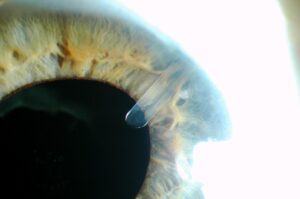Treatments
Congenital glaucoma surgery

What is the congenital glaucoma surgery?
Congenital glaucoma surgery includes several techniques that are performed at very early ages to avoid damage to the optic nerve due to an increase in intraocular pressure due to alterations in the drainage mechanism of the aqueous humour (a fluid that is inside the eyeball).
Where the diagnosis is given at birth, it is wise to considering operating immediately, consulting with expert ophthalmologists not only in glaucoma but also in child eye surgery. Furthermore, when the congenital glaucoma operation is not performed as early as possible, there is a significant risk of an irreversible loss of vision.
Techniques
The different surgical techniques aimed at treating congenital glaucoma are based on correcting the alterations in the drainage mechanism of the aqueous humour or on building a new drainage route when the existing one cannot be reconstructed. Depending on the transparency of the cornea (the layer covering the front of the eye), our ophthalmologists may choose one of these main procedures:
- Goniotomy: this is performed when the cornea is still transparent, as it enables us to enter the eyeball by making a small incision in its surface. Once we have access to the anterior chamber of the eye, we unblock the aqueous humour drainage channel known as the trabecular meshwork. This is the most common congenital glaucoma surgery, as this disease is often associated to the presence of embryonic tissue in the drainage route that simply needs to be removed to re-establish the correct flow of aqueous humour.
- Trabeculectomy: we generally perform this congenital glaucoma surgery when the cornea has lost transparency and we are unable to access the inside of the eye. The trabeculectomy is a technique that we also perform on adults with glaucoma and that, in this case, we adapt to the characteristics of the eye of the child and of the paediatric patient.
- Glaucoma drainage devices: in more complex cases or those that do not respond to other techniques, this surgery might be necessary.
Eye diseases treated
When glaucoma is present in babies or children under the age of three, this is called congenital glaucoma and the only solution to this problem is surgery, although after we have administered medication to control the intraocular pressure while we schedule the surgery.
Recovery
Both the goniotomy and the trabeculectomy are performed using minimally invasive procedures that not only increase the success rate but also have a lower risk of complications. Thanks to this, most patients with congenital glaucoma reach adulthood with a degree of vision that enables them to cope in their everyday lives.
At the Miranza clinics, out team supports the child and the family during each stage of the surgical process and the corresponding follow up, indicating all the guidelines to follow and explaining the post-operative treatment (anti-inflammatory and antibiotic drops to reduce the swelling and avoid post-surgical infection) and the guidelines for check ups. A very strict control of the child is necessary in order to assess the need for further surgery in the future and to pay special attention to any visual alterations that may arise, such as strabismus, lazy eye or myopia.


